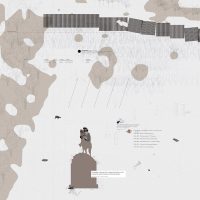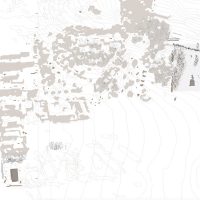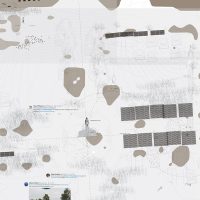2nd Floor, 138 Jan Smuts Avenue Parkwood Johannesburg South Africa, 2000
Johannesburg: 26.1497° S, 28.0342° E London: 51.5072° N, 0.1276°
Enquiries: info@counterspace-studio.com Press: comms@counterspace-studio.com
““Its scars are engraved in the memories, histories, geographies, politics, institutions, and architecture of the colonized.” ”
— Oliver Mtapuri, Betty C Mubangizi, and Simao Nhamb
Nick Axel: As you move through this series of drawings, you start to realize you’re moving through a landscape, one that’s inscribed with history. The first drawing, however, is more abstract. No matter how hard you look, you're not going to find exactly what it represents. What type of space is this?
Sumayya Vally: The first drawing in this series references a historical protest route in Pretoria, the administrative capital of South Africa. On the one end is the Voortrekker Monument, and on the other are the government's Union buildings. Between these two places you pass through several sites of protest. Some of them are significant, and some of them are not, at least not in a conventional sense. What you see in this first drawing are shadows. I'm very interested in things that happen in the shadows. In shadow practices, digital shadows, shadow economies, and so on. In this instance, however, they are physical shadows, and represent a relationship between bodies and space. These shadows, these places, are where people might meet and organize themselves, or rest along the route. And in representing a processional route, I’m also drawing attention to the act of walking in the city as a form of embodied research. This is the way that of people can assert themselves, and reconstitute, reconfigure, and transgress territories. So often, black bodies have to traverse huge distances to access economic opportunity. There isn't much dignity in walking in public space. Shade is also about dignity.
At 09:34am on May 18, 2017, with a red EFF coat over Paul Kruger’s shoulder, the hock block was loaded and Paul Kruger was shifted 525 millimeters off-center. Sumayya Vally, Choreography of a Procession, 2021.
“Wathint’Abafazi Wathint’imbokodo!” (“you strike the women, you strike the rock!”) chanted women on August 9, 1956 on the doorstep of the government's Union buildings, some carrying young children on their backs, some wearing traditional dresses and sarees, and others clothed in their domestic work outfits. In the ten minutes of silence that followed, not a single baby cry was heard. Sumayya Vally, Choreography of a Procession, 2021.
From behind the barricaded fence of blue dress uniforms and riot shields, they sing the Amakomanisi struggle song"Ubaba wami wayengumfana wasengadini, umama wayeyintombazane yasekhishini, yingakho ngingumKhomanisi" ("My father was a garden boy, my mother was a kitchen girl, and that’s why I am a communist!"). Sumayya Vally, Choreography of a Procession, 2021.
NA: It’s also a question of health and survival. The lack of shade on the US/Mexico border, for instance, is intentional, and weaponized as a deterrent. Shade provides a degree of safety. But if we try and read this first drawing as a map, the drawing resists. There's no traditional infrastructure. There are no sidewalks. There are no roads. It's just the connection of different spaces that are bound together in a different way.
SV: That is also what occupation can be, or do. Events like protest and festival reorder terrain. Places that were intended for cars become occupied by bodies. Fences that were meant to keep people out become surfaces to amplify protest. A McDonald’s, or a Shell gas station becomes public space.
NA: You've organized these drawings into different series, which each seem to have a consistent scale. But moving from one series to the other is not linear; it’s not like zooming in or out. This is also reflected in the captions, where some series have very detailed ones, while others are just geographic coordinates. How do you understand the idea of scale here?
SV: The first series is made of small moments of protest, and show how they start to function as an infrastructure for people to latch onto. The second series works with monumental territories, so to speak. Each coordinate points to a site that is of significance in terms of what a protest has worked to unsettle, or the power that it's speaking back to. The third series shows underrecognized urban spaces that become political through their participation in the act of protest. Scale, in this sense, is not just about a unit of dimension and measurement. It's also about defining a set of relations, or meaning.
NA: Do you see drawing as a way to expand the archive?
SV: When I started making these drawings, I started thinking about all those really awful Johannesburg typologies like the strip mall, the filling station, the drive through. But these have sometimes actually come to function as important public spaces, especially given the lack of public space that we have. The car wash, for example, is also a social space: they are spaces to wait for taxis, and informal trade and other economies flourish around these areas, transforming them into vibrant spaces. Through the act of drawing we can recognize something that's not usually seen as important.
NA: In this sense, it’s equally important what is and isn’t seen. The blank space in these drawings carries an incredible significance.
SV: Absolutely. Every single line on these drawings has meaning. Working to erase and obscure is also a political act.





